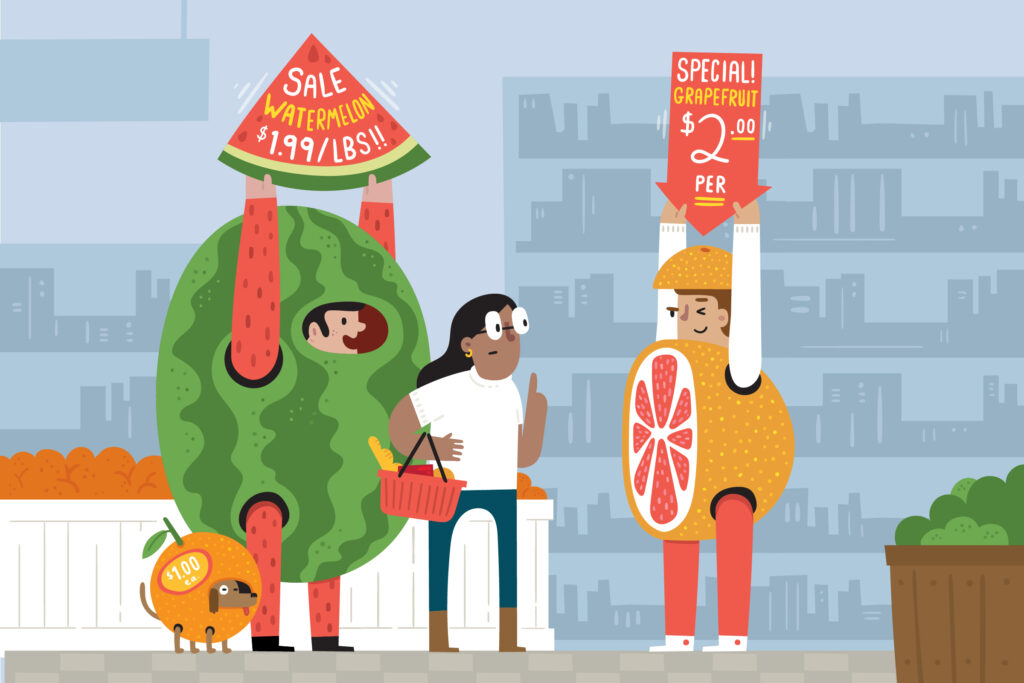Is it better to buy mandarin oranges by the fruit or by the pound? How about grapefruit? Watermelon?
University of Georgia marketing researchers have found that shoppers’ perceptions of the value of grocery staples vary depending on the physical size of the product and how the price is presented. Specifically, shoppers perceive larger items are a better deal when sold by the pound, but smaller items are a better deal when sold by the unit — even when the prices are essentially the same.
Sarah Whitley, assistant professor of marketing at Terry, joined coauthors Julio Sevilla, Terry marketing professor, and Seattle University marketing professor Mathew Isaac, to publish “Units or Pounds? How Anchoring on Salient Price Information Influences Perceptions of Product Value” in the Journal of Marketing Research this summer.
Whitley was inspired by a moment of shock at a cash register when a melon in her cart cost close to $10.
“They were $1.99 a pound, and I thought, ‘That’s a good deal, nice!’” she said. “So I got one, and when I checked out, it was $8. I thought to myself, ‘Why didn’t I anticipate that it would cost that much?’ For some reason, even though I knew this melon weighed more than a pound, my brain was still focusing on the first number that I saw.”
Whitley wanted to understand why her brain was fixated on the per-pound price of her prize melon and how the phenomenon — which psychologists call anchoring bias — might affect how we buy groceries.
She worked with Sevilla — whose past research focused on how shoppers perceive display space, packaging, and the size and selection of products — to measure how grocery shoppers perceive produce prices.
Their team ran a series of 14 studies with nearly 9,000 online and student participants in which participants were asked to rate the value of produce items of different sizes. Some items were priced per pound, others priced per item, but the overall price was the same in each comparison.
Overwhelmingly, when larger items were sold per pound, they were rated as much better deals. When smaller items were priced by the unit, they were rated as a better deal. Even when shoppers were given a per-pound price and exactly how much an item weighed, they were still more likely to pick up a small item if it had a per-unit price and a large item if it was priced per pound.
“There’s this insufficient adjustment that we’re doing around the anchoring process,” she said. “The first number we see holds so much weight, regardless of whether another pricing format is given. People just kind of look at the first number and make their decision.”
In field experiments at an upscale deli counter, shoppers bought more small items (risotto cakes and salmon filets) when they were priced per unit rather than per pound. In another study — in which researchers sold bags of trail mix in a university student union — they were able to increase sales by 90% by pricing small bags of trail mix per unit versus pricing them per pound.
Our brains run on cognitive shortcuts, and anchoring bias — when a person relies too heavily on the first piece of information offered when making decisions — is a powerful shortcut, Whitley said.
Her research could be used by stores today to help maximize the sale of produce and deli products, but policy makers could also use perception of grocery prices to encourage healthier eating habits by making healthier foods more appealing from a value standpoint.
“This effect could be used to nudge healthier behaviors,” Whitley said. “You could price the healthier foods in a way that makes them more attractive. For less healthy items, a consumer protection agency might push for them to be priced in a way that would make them less appealing from a value standpoint. We do not test this specifically, but we do demonstrate that a simple change in how the price format is presented can really change people’s behavior.”

